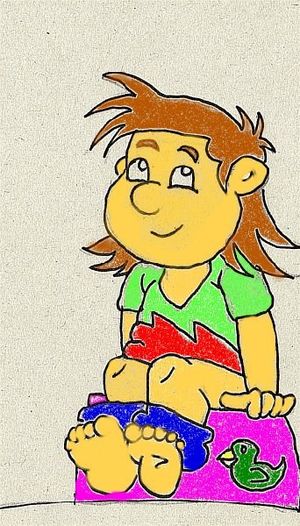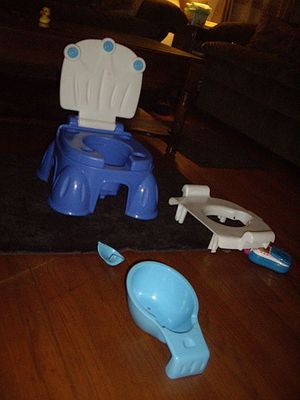Toilet training

Toilet training (or the more colloquial term potty training) is the process of weaning a young child off diapers (or "nappies" in Commonwealth countries) and training the child to use the toilet for urination and defecation.
Toilet training trains the control of bladder and bowel movement/sphincter control such that natural urge to urinate or defecate is not given in until the right time has come and the right place, such as a toilet, has been reached. See also self-control.
Toilet training is usually started and completed between the ages of 12 months and three years. Girls typically master toilet training 3 to 6 months earlier than boys.
History
Formal toilet training is a relatively recent phenomenon. It is necessary because contemporary society requires privacy for the act of excretion. Before the widespread social adoption of the private bathroom, most children learned toilet skills simply by observing. Such is still the case in countries where few members of society have private bathrooms.
In Western culture, in past generations, changing and washing diapers involved a lot of work and this was part of the reason why children were toilet-trained as early as possible, normally between 12 and 24 months of age. Today, in many cultures such as the United States, parents tend to take their time to do the toilet training in a more relaxed fashion, and it is not uncommon for a 4-year-old to still need diapers.
Methods
Toilet training usually involves the techniques of praise or reward as positive reinforcement. The child is regularly seated on the potty in order to defecate and/or urinate there, and is praised when successfully doing so. The child is also taught to communicate verbally when they need to go potty, and praised when they manage this.
In past generations, negative reinforcement was often used in toilet training too, such as reproof and what was thought to be forms of age-appropriate punishment for non-cooperation and for soiling their diapers or clothing at an age where a child should have learned the necessary skills. 100 years ago, toilet training was often very strict. Babies were allegedly sometimes tied with rope to the leg of a table while seated on the potty, to be released only after they had used it - a method that seems cruel and abusive by modern parenting standards.
Psychology
Sigmund Freud believed that toilet training is among the most formative events of the human psyche because it is the child's first introduction to the fact that social imperatives can take precedence over bodily desires. He also believed that a child can have problems later in life if the toilet training does not go well, or is too strict.
For example, as an adult a person could strive for perfection or excessive cleanliness because they were too harshly trained. The current popular wisdom on this subject is that toilet training is a mutual task, requiring cooperation, agreement and understanding between both the child and the caregiver.
Today, it is strongly recommended that coercion and shame are not used as disciplinary instruction tools during this phase of development, and the best potty training techniques emphasize consistency and positive reinforcement over punishment.
Other
In certain medical conditions, toilet training or retraining is also necessary at older age.
Domestic animals, such as dogs, are also toilet trained. This is called housebreaking.
See also
| Diaper related topics |
|---|
Chat rooms • What links here • Copyright info • Contact information • Category:Root
